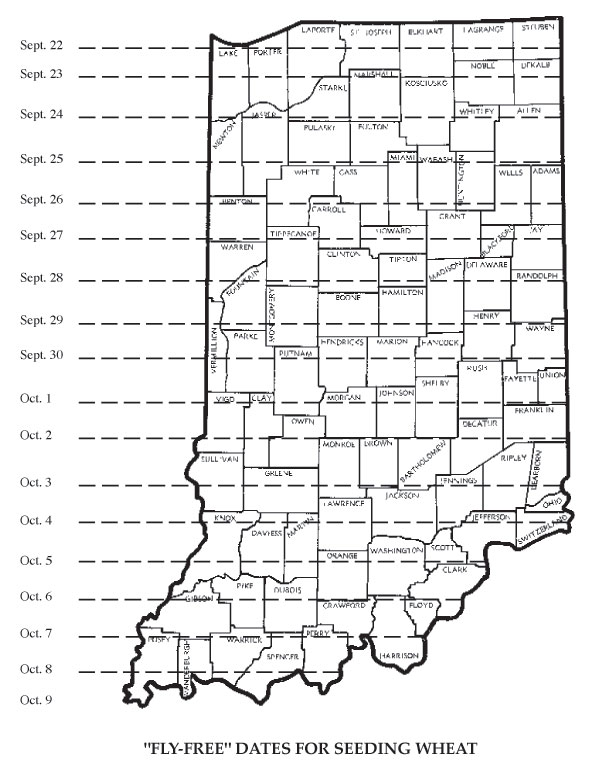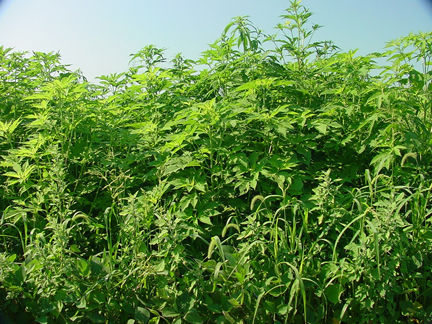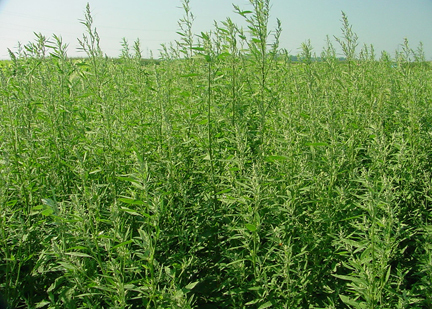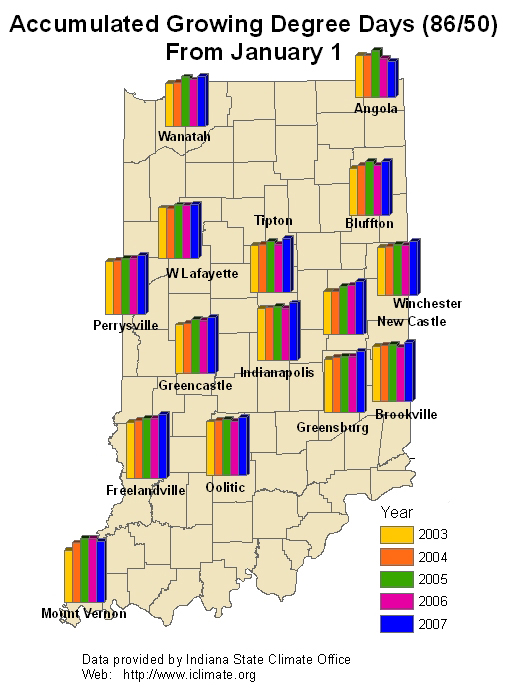Pest & Crop Newsletter, Entomology Extension, Purdue University
- Reports of Hessian Fly Damage Continue to Rise
- Nematode Update - Should Corn Growers be Alarmed About the New Corn Cyst Nematode?
- Black Light Trap Catch Report
- Monitor Corn Fields for Weakened or Diseased Stalks
- Hybrid Selection: Where's the Beef?
- Bin-run Wheat Seed
![]()
Reports of Hessian Fly Damage Continue to Rise – (Brandi Schemerhorn and Sue Cambron)
- Reports of Hessian fly in several Indiana counties.
- Remember to utilize fly free dates.
- Destruction of volunteer wheat helps reduce insect reservoir to avoid spring infestations.
This year’s wheat crop in Indiana was hit hard by both a late heavy frost as well as Hessian fly infestation making an accurate account of Hessian fly infestation difficult. Spring infestation resulted in yield loss due to lodging caused by Hessian fly larval feeding.
The Hessian fly is present in wheat growing areas throughout the US, including Indiana. Even if wheat is not planted in a particular area, the Hessian fly can survive on alternative grass hosts. When the opportunity presents itself for a wheat infestation, there is potential for rapid increase of fly populations as a result of weather conditions or cropping practices that favor survival of eggs and young larvae in the fall.
A low fall infestation often goes unnoticed due to the tillering of the wheat plant. Much of the fall fly population can be avoided by planting after the fly-free date. This is key to avoiding subsequent infestation by the spring brood. Additionally, it has been shown that following the fly-free date will help reduce wheat disease problems and reduce winter-kill from excessive growth. Crop rotation is one of the key management strategies for reducing Hessian fly problems.

Test plots showing resistant and susceptible wheat
The Hessian fly passes the summer in the stubble of the current wheat crop. Plowing the stubble results in the destruction of the pest. Volunteer wheat germinates and begins growing just in time for the fall emergence of the Hessian fly. These plants are readily infested resulting in a rapid build-up of the population. Removal of volunteer wheat before the emergence of the fall brood greatly reduces the insect reservoir for a spring infestation.
The single best tool for preventing fall infestation is planting after the fly-free dates for your area.

![]()
Nematode Update – Should Corn Growers Be Alarmed About the New Corn Cyst Nematode? –(Jamal Faghihi, Christian Krupke, and Virginia Ferris)
When it comes to nematodes associated with corn most growers and crop advisors are aware of the needle nematode, which is capable of causing extensive damage in some corn fields. In soybean we also know about the Soybean cyst nematode, a perennial problem in most soybean growing areas of the United States that causes extensive yield losses in soybean under stress, as during this year. However, two recent developments have caused some concerns to all involved with corn and soybean production.
First, a report of finding a Corn Cyst Nematode in Tennessee by our colleagues from Tennessee and Missouri. Since 1981, we have known about the presence of a species of cyst nematode, Heterodera zeae, that is capable of parasitizing corn and causing yield loss in Maryland. There are no indications that this nematode has spread to other corn fields beyond the point of original discovery. Early indications are that the cyst nematode found in Tennessee is different from the corn cyst nematode found in 1981 in Maryland. Corn cyst nematodes are able to reproduce only on corn and other grasses, including grass weeds. While they are similar to soybean cyst nematode in appearance, they are unable to parasitize any broadleaves including soybean.

Corn cyst nematodes (Photo credit: Heinz and Mitchem)
Second, this summer we found several corn fields infested with another nematode called lance nematode. Unlike corn cyst nematode, lance nematode is capable of parasitizing both corn and soybean and causing extensive damage with numbers of less than 100/100 cc of soil. We found several thousand individuals of this nematode/100cc of soil in some of the corn samples that we received this season. Lance nematode can feed both outside and inside of the root system. They are tube-like, and less than 1/16th of inch long. Because they are transparent we cannot see them on the roots. The only way to find them is to take soil and root samples of the suspected plants and send them to a Nematology laboratory for analysis. The sampling method is similar to the one described for needle nematode <http://www.entm.purdue.edu/nematology/samples.htm>. Lance nematode is capable of causing problems throughout the season and thus we can sample for them throughout the season. Corn infested with lance nematode are stunted and their root system is poorly developed and these symptoms remain throughout the season. If you have had unexplainable problems in both corn and soybean, lance nematode could be the problem.
Back to the question, should we be concerned about corn cyst nematode in Indiana? The short answer is, ”not yet.” We have to be vigilant and keep our ears to the ground and occasionally look for the cysts on corn roots, something that we have not been doing in the past. As for the lance nematode, we have to wait and see if the pattern of high numbers will continue in subsequent seasons.

Corn cyst nematodes on root (Photo credit: Heinz nd Mitchem)
If you have any question about these or any other kinds of nematodes, you can contact Jamal Faghihi at 765-494-5901 or send an email to jamal@purdue.edu. Soil samples for nematode analysis can be sent to: Nematology Laboratory, Purdue University, Department of Entomology, Smith Hall, 901 W. State Street, West Lafayette, IN 47907-2089.
![]()
Click here to view the
Black Light Trap Catch Report - (John Obermeyer)
Weed Science Surveys II: Burndowns and Application Timing– (Glenn Nice, Bill Johnson, and Tom Bauman)
In weed science and other disciplines, surveys are often used to inquire about a group’s habits or decision practices. In 2003 and 2005, mail out surveys were sent to 3000 and 5000 growers in Indiana, 612 and 1330 were returned, respectively. The surveys asked a series of questions about burndown practices used in no-till soybean production in Indiana. Most of the growers responded that burndown applications were applied 7-14 days before planting (46%)1, Nineteen percent responded that they applied burndowns within 7 days of planting and 9% responded that they applied in the fall or over 30 days before planting. Growers averaged across farm size indicated that approximately 95% of their soybean acres were Roundup Ready®. However, there appeared to be a slight decrease in the percent of Roundup Ready® soybean grown compared to non-transgenic acres as farm became larger. Of these glyphosate-resistant soybean acres, an average of 26% received a residual preemergence treatment, indicating that a large percentage of Roundup Ready® soybeans are treated with only glyphosate. When broken down by farm size, larger farms (500 acres and above) were more likely to use a preemergent herbicide. This might be a result of time management. With more acres to cover, the use of a preemegence would increase the window for the application of postemergence herbicides.
The perceptions regarding weed-free periods and early season competition were uncertain. When asked if planting into a weed-free seedbed was important only 37%, thought it was important to plant into a weed-free seedbed. Fifty one percent of the growers surveyed responded that soybean could tolerate 1 to 2 weeks of weed competition without yield loss while 17% thought soybeans could tolerate 5 weeks or more of weed competition. When broken down by farm size, growers from larger farms were more likely to respond this way. Weeds are highly effective at allocating resources, one aspect of their “weedy” nature. Annual grasses emerging at the same time as corn will accumulate at much nitrogen as corn when the grasses are 3 inches in size, but if allowed to grow to 12 inches, annual grasses will accumulated 3 times the nitrogen as corn2.
The majority of growers, 67%, indicated that they did two trips across a field for weed management each year. While 33% only used 1 trip across the field to control weeds. Thirty percent of growers filling out the survey indicated that their postemergence applications were most often based on weed size. Although the Roundup Ready® weed management system can be somewhat flexable, the size of the weed and specific species involved can still be crucial to get control with glyhosate. The appropriate rate has to be applied to the appropriate size of the weed. This is most evident with problematic weeds such as morningglory, lambsquarters, and giant ragweed.

Giant ragweed in a field of soybean (Photo credit: Glenn Nice)
When asked in the survey about lambsquarters, 50% of the growers responded that they applied postemergence herbicides on lambsquarters at least 4 inches tall. Lambsquarters has a thick epicuticular wax, almost twice as much as common purslane and 37 times more when compared to velvet leaf3. It is this epicuticular wax that inhibits many of our herbicides from entering the plant. In the case of lambsquarters, epicuticular waxes become thicker and change their chemistry in response to light, temperature, relative humidity, and age. Lambsquarters is more difficult to control when it is more than 4 inches tall. Applications to lambsquarters in hot dry weather may result in poor control. Over 30% of the growers indicated that they let giant ragweed reach 8 inches or more in height before spraying glyphosate.

Lambsquarters in a field of soybean (Photo credit: Glenn Nice)
The Roundup Weathermax® label (2007) states the maximum size for giant ragweed is 6, 12, and 18 inch when using 16 fl oz/A, 22 fl oz/A, 32 fl oz/A. Forty one percent of growers in this survey indicated that they applied glyphosate to 4 to 8.5-inch giant ragweed, and horseweed, however, 64% of growers indicated that they applied glyphosate to morningglory that was under 4 inches tall. Presently, the Purdue University and The Ohio State University recommend applying higher rates, 1.1 to 1.5 lb ae/A glyphosate, to common lambsquarter and giant ragweed that are 6-10 inches tall, then follow up with a 0.75 lb ae/A applications to survivors approximately three weeks later.
Next week, some results from a survey conducted that investigated growers perceptions of glyphosate resistance.
1) Johnson, W.G., K.D. Gibson, and Shawn P. Conley. 2007. Does weed size matter? An Indiana grower perspective about weed control timing. Weed Technol. 21:542-546.
2) Johnson, W.G. 2006. Nitrogen accumulation by annual grass weeds in Roundup Ready® corn production. <http://www.btny.purdue.edu/weedscience/2006/NitrogenAcc06.pdf>
3) Sanyal, D., P.C. Bhowmik, and K.N. Reddy. 2006. Leaf characteristics and surfactants affect primisulfuron droplet spread in three broadleaf weeds. Weed Sci. 54:16-22.
![]()
Growth Regulator Tolerant Crops – (Glenn Nice)
Agriculture is abounding with genetics. Since 1996 and the release of Roundup Ready soybean agricultural genetics have been leaping and bounding into new territory. This last year, Monsanto released that they were working on a dicamba-tolerant soybean. This search for a dicamba tolerant soybean is partially in response to the development of glyphosate-resistant weeds such as giant ragweed and horseweed (marestail)1. The inclusion of growth regulators to diversify herbicide mode of action would decrease or slow the potential of herbicide resistance development. Furthermore many soybean fields show cupped and strapped leaves every growing season due to growth regulator applications made in corn. The development of tolerant soybean to these herbicides would decrease this common symptom.
Most recently, Dow Agrosciences announced at the Farm Progress Show that they also are working on a growth regulator tolerant line of genetics that will be tolerant to 2,4-D “as well as aryloxyphenoxypropionate ‘fop’ grass herbicides” 2. Both technologies are not available now, but in the testing phase. Dow Agrosciences reported that the technology would be available in 20122.
1) New Results From Southern Hemisphere Field Testing Confirm Momentum in Monsanto’s R&D Pipeline. Accessed August 9th, 2007. <http://monsanto.mediaroom.com/index.php?s=43&item=514>
2) Dow AgroSciences Reveals Progress on New Herbicide Tolerance Trait. August 28th, 2007. <http://www.dowagro.com/newsroom/corporatenews/2007/20070828a.htm>
![]()
Monitor Corn Fields for Weakened or Diseased Stalks– (Bob Nielsen)
During the grain filling period, developing kernels become a significant photosynthetic “sink” for the products of photosynthesis and respiration. Corn plants prioritize the movement of these photosynthates to the kernels, even at the expense of not maintaining cellular health of stalk, leaf, and root tissues.
The primary effect of severe stress on a corn plant (drought, heat, nutrient deficiency, leaf diseases, insect damage, hail damage, consecutive days of cloudy weather) is a reduction in photosynthetic rates. If photosynthetic capacity decreases significantly during grain fill, plants often respond by remobilizing stored carbohydrates from stalk and leaf tissues to supply the intense physiological demand by the developing grain on the ears. In addition to physically weakening the stalk of plants, remobilization of stored carbohydrates and/or the consequent lower cellular maintenance of root and stalk tissues increases the susceptibility of the plant to root and stalk rots.
Reports have already begun to trickle in from several areas of Indiana about weak plants with varying degrees of root and stalk rot development. Fields at higher risk for weakened stalks and stalk rot development will be those where plants have managed to set fairly decent ears but have experienced severe stress during grain fill (primarily drought + high temperatures in 2007). Growers should monitor stressed fields the remainder of this month and into early September for compromised stalk strength or the development of severe stalk rots and adjust their harvest schedules accordingly to harvest these fields early in the season before that one big storm brings the crop to its knees.
Related References
Lee, Chad. 2007. Weak Corn Stalks from Drought. Corn & Soybean News, Univ. of Kentucky. [On-Line]. Available at <http://www.uky.edu/Ag/CornSoy/cornsoy7_7.htm> (URL accessed 8/28/07).
Mills, Dennis, Pierce Paul, and Peter Thomison. 2006. Corn Stalk Rot: A Disease Caused by Several Different Fungi. C.O.R.N. Newsletter, Ohio State Univ. [On-Line]. Available at <http://agcrops.osu.edu/story.php?setissueID=155&storyID=932> (URL accessed 8/28/07).
Nielsen, R.L. (Bob). 2007. Grain Fill Stages in Corn. Corny News Network, Purdue Univ. [On-Line]. Available at <http://www.kingcorn.org/news/timeless/GrainFill.html> (URL accessed 8/28/07).
Shaner, G. and D. Scott. 1998. Stalk Rots of Corn. Purdue Univ. Extension Publication BP-59. Available online at <http://www.ces.purdue.edu/extmedia/BP/BP-59.pm65.pdf> (URL verified 8/28/07).
Vincelli, Paul. 2004. Factors That Could Enhance Stalk Rots in Corn. Kentucky Pest News (Aug 2). Univ. of Kentucky. Available online at <http://www.uky.edu/Agriculture/kpn/kpn_04/pn040802.htm#corrot> (URL verified 8/28/07).
![]()
Hybrid Selection: Where’s the Beef? - (Bob Nielsen)
I can remember the excitement as a kid when the first Christmas mail-order catalogs would arrive in the mail from Sears, JC Penney, or Montgomery Ward. I think some of that excitement lingers today when the seed corn company sales literature arrives in the mail or when I attend a seed company field day in late August or early September and listen to the enthusiastic sales pitches. All the hopes of a record, bin-busting crop for next year are represented in those glossy multi-color pages that extol the virtues of the latest and greatest hybrids with every imaginable biotech trait that promise to beat last year’s hybrid performance by 20 or more bushels per acre.
The reality of hybrid selection today is that pressure to place seed orders comes earlier and earlier than ever before. In the “old days”, a guy would wait until January or February to place a seed order. By then, you would have had the time to peruse yield reports from your local land-grant university variety trials or those from the seed companies to identify the hybrids you wanted to purchase. Today, more and more sales pressure occurs before the current year’s variety trials have even been harvested. What’s a guy to do?
Documented consistency in yield performance is still the key to success in selecting hybrids that will perform well in your farming operation. Sales pitches at field days or in farm magazine advertisements should serve only to heighten your awareness of seed companies, their hybrid traits, or specific hybrids and should NOT take the place of meaningful yield data from well-designed hybrid performance trials.
When you are pressured to choose this hybrid or that one because the sales rep assures you it will perform well, don’t hesitate to ask for the performance data that backs up the recommendation. Be like the little old lady in the 1984 Wendy’s™ hamburger TV commercial who demands to know “Where’s the beef?”.
Even though you are making hybrid selection decisions in August or September, take the time to peruse the results of variety trials from the previous year. Except for the newest of hybrids, performance data from the previous year are useful for identifying consistent performers for your operation next year.
How do you identify consistent performers that will likely perform well for you? The secret lies in looking for trials that evaluate hybrids over multiple locations. Multiple testing locations in a single year represent possible weather patterns your farm may encounter in the future. Weather variability influences hybrid performance more than any other variable, because weather interacts with most of the other yield limiting factors. If a hybrid performs consistently well over many sites (i.e., weather patterns), then it will likely perform well on your farm in the future.
(Please, re-read the last paragraph. Its message is the most important one in this article!)
Most university hybrid performance programs evaluate hybrids over multiple locations plus multiple years within select maturity zones. Several third-party testing groups also evaluate hybrids over multiple sites. Seed companies obviously evaluate hybrids over hundreds if not thousands of sites each year. Seek out summaries over many locations and avoid concentrating on single site results.
For multiple site trials where the data have been statistically analyzed, consistent performers are mostly likely found within the upper group of similar-yielding hybrids as determined by a trial’s L.S.D. value. For multiple site trials for which statistical analysis of the data has not been performed, you can identify consistent performers by evaluating hybrid performance relative to the average yield of the trial or relative to the maximum yielding hybrid in a trial.
For example, look for those hybrids that consistently yield 5% above the average yield of trials in which they are entered. If the trial average yield is 180 bpa, look for hybrids yielding 189 bpa or greater (180 x 1.05).
Another way to look for consistent performers is to identify hybrids that consistently yield at least 90% of the maximum yielding hybrid in a trial. If the highest yield in a trial is 225 bpa, look for hybrids that yield 203 bpa or greater (225 x 0.90).
Remember, the key factor in choosing hybrids for your farming operation next year is documented performance against a range of competitors, not simply specific head-to-head comparisons. Once you have identified a group of otherwise consistent high-yielding hybrids, further filter them for traits important to your situation. For example, corn following corn demands hybrids with superior resistance to important foliar diseases such as gray leaf spot or northern corn leaf blight.
Related References
Purdue Crop Performance Program. 2007. Purdue Univ. Agronomy Dept. [On-Line]. Available at <http://www.agry.purdue.edu/pcpp/index.html> (URL accessed 8/27/07).
Univ. of Illinois Variety Testing Program. 2007. Univ. of Illinois Crop Sciences Dept. [On-Line]. Available at <http://vt.cropsci.uiuc.edu> (URL accessed 8/27/07).
Kentucky Grain Crops Variety Trials. 2007. Univ. of Kentucky Plant & Soil Sciences Dept. [On-Line]. Available at <http://www.uky.edu/Ag/GrainCrops/varietytesting.htm> (URL accessed 8/27/07).
Michigan State Variety Trials. 2007. Michigan State Univ. Crop & Soil Sciences Dept. [On-Line]. Available at <http://www.css.msu.edu/varietytrials> (URL accessed 8/27/07).
Ohio Crop Performance Trials. 2007. Ohio State Univ. Horticulture & Crop Sciences Dept. [On-Line]. Available at <http://ohioline.osu.edu/~perf/index.html> (URL accessed 8/27/07).
Soy Capital Ag Services. 2007. (Select “seed testing” from sidebar menu). [On-Line]. Available at <http://www.soycapitalag.com> (URL accessed 8/27/07).
Icorn.com. 2007. Third Party Yield Data. [On-Line]. Available at <http://www.icorn.com/yielddata.aspx> (URL accessed 8/27/07).
F.I.R.S.T. 2007. Farmers Independent Research of Seed Technologies. [On-Line]. Available at <http://www.firstseedtests.com> (URL accessed 8/27/07).
![]()
Bin-run Wheat Seed - (Herb Ohm)
It is tempting to plant wheat with “bin-run seed” to “reduce” input costs for commercial production. Use of bin-run seed is especially tempting when wheat market price is low, cost of seed wheat is high, and if one inputs other “low management” production practices, such as soil/field areas that have low productivity, limited fertilizer application and little or no fungicide/herbicide application.
There are ample field trial performance results that indicate favorable input cost returns on various good management practices for wheat production, including high quality processed seed wheat. Cost returns of high quality seed wheat, compared to use of bin-run seed, are especially favorable following a growing season in which one or another disease of wheat or unfavorable weather pattern was a significant wheat production limitation.
Disease infection, low soil fertility, moisture and heat stress, all cause varying degrees of reduced grain yield and wheat seed quality. Limited soil fertility, moisture, and heat stresses result in widely varying seed size and significantly increased percentage of small seeds, resulting in reduced seedling vigor and low emergence.
Diseases also result in increased percentage of small seeds. But certain diseases, like fusarium head blight (head scab) also cause low germination and infected seedlings. Seeds from fusarium-infected spikes can have varying degrees of infection; some infected seeds can appear fairly normal, but are poorly developed and lightweight, and have low germination. Proper seed processing can eliminate many of these diseased and lightweight seeds.
Seed treatment with chemicals helps reduce seedling diseases that negatively impact seedling vigor, and other diseases that germinate and develop along with the developing wheat plant, like loose smut. Other chemical seed treatments kill aphids that transmit Yellow Dwarf Virus when they feed on the wheat seedlings. Yellow dwarf disease is especially devastating if transmitted into emerging wheat seedlings and in early seedling stages.
Typically in Indiana, aphids move from corn and perennial grasses in the fall season into wheat fields at wheat emergence and during early wheat growth as the corn matures. Yellow dwarf infection in wheat is especially devastating and prevalent in fall seasons in which weather temperatures remain warm through November, like in fall 2006.
Aphids are re-introduced in spring, usually beginning in early April, into northern areas like Indiana on wind currents from areas to the south. These aphids then transmit the Yellow Dwarf Virus into perennial grasses and cereal grasses, like spring seeded oats and winter wheat. Spring infection of yellow dwarf is devastating in spring oats (like fall infection in winter wheat, seeded in the fall) but is not as severe in winter wheat.

Purdue wheat research plot
Bottom line: seeding with high quality processed seed wheat, especially in combination with other good management wheat production practices is an excellent investment.
Related References
Beuerlein, Jim, Pierce Paul, Clay Sneller, and Rich Minyo. 2007. Ohio Wheat Performance Test. Ohio State Univ. & OARDC. [On-Line]. Available at <http://www.oardc.ohio-state.edu/wheattrials/default.asp?year=2007> (URL accessed 8/28/07).
Bruening, B., C. Tutt, S. Swanson, J. Connelley, G. Olson, N. Mundell, A. Clark, and D. Van Sanford. 2007. Kentucky Small Grain Variety Performance Test. Univ. of Kentucky. [On-Line]. Available at <http://www.ca.uky.edu/agc/pubs/pr/pr551/pr551.pdf> (URL accessed 8/28/07).
Purdue Small Grains Management Web Site. 2007. Purdue Univ. Agronomy Extension. [On-Line]. Available at <http://www.agry.purdue.edu/ext/smgrain> (URL accessed 8/28/07).
Spears, Jan and Randy Weisz. 2004. Planting Farmer Saved Wheat Seed: Are You Really Saving Money? North Carolina State Univ. [On-Line]. Available at <http://www.smallgrains.ncsu.edu/Guide/Chapter4.html> (URL accessed 8/28/07).
![]()


